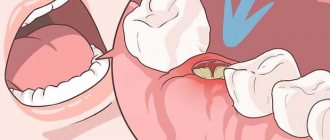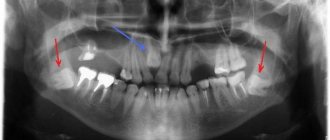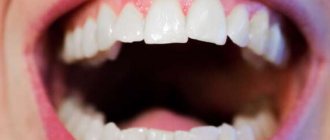international experience
In different countries, the answer to the question: “Do you always need to remove wisdom teeth?” different. In the USA, 8s are removed already in adolescence, before they lead to problems, that is, they act according to a preventive scenario. In the CIS countries, if teeth erupt correctly and do not cause problems, they are left behind. Apparently this is due to the characteristics of healthcare models.
At the same time, many scientific works on this problem among conscript soldiers in the Russian Federation attract attention, and it is no coincidence. It is at this moment that wisdom teeth begin to actively grow and reveal previously hidden problems. And treatment often requires surgery.
What does facial asymmetry mean?
Asymmetry of the face and lips is often an acquired form of imbalance in the muscles of the face and neck, which appeared as a result of an imbalance in the anatomical and physiological balance. Any action in the oral cavity aimed at changing the occlusion (even the installation of one small filling), not to mention orthodontic treatment or the manufacture of many crowns and bridges, cannot but affect the 28 cranial bones that make up the human skull. Therefore, treatment of asymmetry of the face and lips should be considered as a reverse unwinding of the processes that led to the disorders.
The human body is much more than just a combination of “measurable parameters”; it is an “open system” that constantly interacts with the environment, with its intellectual and emotional characteristics that react to any influence much more actively than physical parameters. Treatment of asymmetry of the face and lips, chin and cheek muscles consists of using self-regulation and self-control mechanisms.
The benefits of stimulation techniques in treating asymmetry go much deeper than the eyes can see. An example of a stimulation method is the use of the ALF device system (orthodontic light wire technique), restoration of the height of the vertical parameters of the chewing and frontal sections, restoration of normal function of the jaw joints (mouth opening 48-50 mm, absence of clicks and sounds in the joints, free movements of the jaw from side to side). side, 12 mm).
Development of normal jaw sizes, characteristic of each individual (strictly calculated by the width of the teeth in each section of the jaw). Treatment also involves restoring the relationship of the upper and lower jaws, raising, if necessary, a drooping eye (working with the middle part of the skull). Osteopathic effects on the cranial bones also expand the range of therapeutic effects of facial and lip asymmetry. And only after all these stages have been restored, the work takes place at the dental level. Since teeth are the final link of all structural disorders of the skull and posture.
Treatment of asymmetry of the face and lips will also include correction of posture and the position of the pelvic bones. This comprehensive approach to the treatment of asymmetries is widely used at the Dental Spa Center.
An individually drawn up treatment plan after a comprehensive diagnosis of the problem is solved through the joint cooperation of the patient and doctors. The doctors of the Dental Spa Center treat all the wishes and needs of patients with care and concern. Call and start treatment for facial and lip asymmetry today! 8928-229-78-83
What is the diagnosis
Doctors often use 2 terms when describing problems with wisdom teeth.
Retention – when a tooth fails to erupt. It grew, but remained inside the jaw completely or partially. This can create a focus of inflammation, which either subsides or worsens again. But the most unpleasant consequence can be a cyst around the tooth if it has not erupted at all.
Dystopia is an abnormally positioned tooth, for example, horizontally. At first, such a tooth germ may not bother you at all. But when it starts to grow, it can lead to a lot of problems. You also need to remember that the tooth simultaneously grows in 2 directions towards the crown and towards the roots. If such a rudiment is tilted, then the tooth may appear from the side of the cheek or, conversely, grow inside the mouth and scratch the tongue.
One of the options for dystopia is a horizontal arrangement.
During the process of growth, a slightly inclined tooth in a narrow jaw can “catch” on the neighboring one, which will lead to an accident. The growing tooth will turn around and lie horizontally. Further, the growing tooth can gradually displace the remaining teeth and lead to crowding of the front teeth. This will create a new problem, not only an aesthetic one, but daily hygiene becomes more difficult and the risk of caries increases.
Often dystopia is combined with retention, which provides more reasons to remove problematic eights.
How to keep your gums healthy after wisdom tooth removal?
The functional purpose of wisdom teeth is very limited. Interestingly, the benefits from them are less than the possible problems. Firstly, the wisdom tooth does not always erupt completely. It is not uncommon for the upper part of the tooth to remain under the gum, or for the tooth to begin to grow sideways. In addition to an unfortunate location that does not allow effective cleaning, wisdom teeth can cause pain when eating and can injure soft tissues (the inside of the cheeks and gums). A combination of factors leads to an increased likelihood of dental caries and other diseases. Moreover, often the process of tooth decay can go unnoticed, and then turn into inflammatory and infectious processes, in which neighboring, healthy teeth come under attack. For these and a number of other reasons, the initiative to remove a wisdom tooth comes from the patient himself. Due to its uncharacteristic structure, such a tooth may have unusual features (such as intertwined roots), which complicates the removal process and increases the time required for complete healing of the place where it was located.
We list the main types of complications that arise:
- acute inflammatory processes in soft tissues, bleeding is also possible
- infectious processes accompanied by suppuration and flux
- cyst formation
- increase in body temperature
- pain and nerve damage
In all of these cases, the cause of complications is not the fact of tooth extraction itself, but insufficient or careless oral care and violation of basic hygiene rules. Most often, a complete list of recommendations for the healing period is given by the attending physician. They may be private. The general rules are simple:
- refrain from eating food for 3 hours after the removal procedure
- Avoid taking medications that affect blood clotting, as well as alcoholic beverages
- After each meal, rinse your mouth warmly (for these purposes, you can use a decoction of chamomile, sage or oak bark)
- eat food at room temperature, giving preference to dishes with a soft consistency, avoiding foods that can get stuck in the wound
- include fruits, vegetables, and natural juices in the diet - this will increase the intake of vitamins and minerals into the body, which are so necessary during the recovery period
- starting from the third day, small cold compresses can be used to relieve pain
To relieve pain and speed up the healing process, the doctor prescribes a course of medications, both analgesic and anti-inflammatory. In some cases, antibiotics may be prescribed. Failure to adhere to the medication schedule has a negative impact on treatment and can lead to the complications mentioned above. It should also be taken into account that, along with what needs to be done, there is a list of what absolutely cannot be done: - brush your teeth during the first two days.
- consume extremely cold or hot food or liquids
- in the first three days, eat spicy and sweet foods
- provoke irritation of the tissues surrounding the hole with any objects (toothpick) or fingers
- actively chew on the side where the extracted tooth was located
- go to baths, saunas, take hot baths, and also allow the body to become hypothermic (in this case, the source of cold is wrapped in dense fabric)
- smoke until complete healing, as the high temperature of the smoke negatively affects the removal site and can lead to infection of the wound
It is advisable to refrain from walking on the first day. It is appropriate to temporarily stop playing sports, since active physical exercise increases blood circulation, which creates a load on the blood vessels.
An increase in temperature is not yet a sign of complications - it is, first of all, a natural reaction of the body. At the same time, the first three days are characterized by aching pain in the jaw. However, if the temperature rises to more than 38.5 degrees, and the pain cannot be relieved with analgesics prescribed by the doctor, do not hesitate to consult a doctor (in severe cases, call an ambulance). Do the same if the temperature rises again after three to four days. Only by immediately contacting a dentist will it be possible to prevent acute inflammation or the spread of infection.
Following the listed tips, recommendations and contraindications helps speed up the final healing process and avoid new problems or complications.
Risks
There are genetic features that do not change, but there are those that depend on various factors, including age.
Facial structure
One of the easiest ways to determine whether there is a greater or lesser risk of problems with wisdom teeth is through a mirror. Let's pay attention to the face. If it is elongated from bottom to top, has narrow cheekbones, and people say a small, neat face, then there may not be enough space for wisdom teeth. But the wider the cheekbones, the wider the “bone”, the more space there is for cutting figure eights.
Also, sufficient space in the jaw reduces their crowding and creates conditions for good hygiene. And this is the best prevention of caries, not only of the seemingly unnecessary tooth that we inherited from our ancestors, but also of all other teeth.
A consultation with an orthodontist and radiation diagnostics (X-ray/MRI) will help you understand the situation.
Age dependent
Problems that can arise with wisdom teeth at different ages can vary significantly2.
In youth, the main problem is inflammatory processes during the eruption of wisdom teeth. As well as the need to remove them for orthodontic treatment.
In adulthood, those who have retained their teeth begin to experience caries. The occurrence of pulpitis and cysts usually leads to a surgeon for removal.
In old age, the main problem is periodontal disease, which usually also leads to the removal of wisdom teeth. Or it becomes a preparation stage for prosthetics.
Features of wisdom teeth
Despite the anatomical structure identical to the rest of the molars, wisdom teeth have distinctive properties:
- Appearance. Although from an anatomical point of view wisdom teeth are no different from other molars, from a visual point of view they can have a rather unpredictable structure and appearance. This is especially true for the upper “eights”, because they have an unusual crown structure. The molars of the lower row have an imperceptible difference from the rest of the teeth.
- Lack of chewing function. Wisdom teeth do not take part in the process of chewing food. The loss of this function was influenced by evolution. For this reason, eights are most often susceptible to various dental diseases, because chewing food makes it possible to stimulate blood flow in the oral cavity and avoid the formation of plaque and tartar.
Why is it so scary
Whether wisdom teeth need to be treated or removed immediately is not easy to decide. They are inconvenient to treat either for patients or for dentists themselves. The former “run out of steam” in the chair, trying to open their mouths wider, while the latter must show all their dexterity in order to reach the problem tooth. A dentist can even cure a difficult tooth, but the gum pockets around the gums can constantly become clogged with food, then the “carious monsters” again attack the tooth and all efforts are in vain.
If pulpitis occurs, rarely will anyone undertake root canal treatment. Roots in the amount of up to 5 pieces, adhesions, shapes in the form of hooks and squiggles, will become an impenetrable labyrinth for any speleologist dentist.
So, having suffered and spent N amount of money, many come to the logical result - “Delete!”
But removal can be just as scary as treatment. According to studies, complications occur after removal in more than 50% of cases3. They are often successfully treated, but add sick days and discomfort.
After wisdom tooth removal, there is a high probability of encountering complications.
What if your wisdom tooth hurts?
Removal of wisdom teeth becomes necessary in many cases. Even unerupted teeth can be removed - they can move the roots of neighboring teeth. In any case, only the dentist will be able to make the right decision about whether the disturbing “eights” need to be removed or whether you can try to cure them.
For patients who decide to have their wisdom teeth removed, it is important to take into account that the operation can lead to other unpleasant consequences and complications, and the recovery and healing process in some cases takes quite a long time, especially when it comes to the lower “eights.”
Main indications for wisdom tooth removal:
- Incorrect location of the tooth (impacted tooth, etc.);
- The presence of deep caries;
- Incomplete formation of a molar in combination with its incorrect position;
- The presence of damage to the gum tissue, up to the development of pericoronitis.
Should I delete or not?
Yes. If diseases or complications have already arisen. Or the situation with 3 molars creates a high risk of diseases and their complications. Such cases include:
- lack of space in the dentition. Crowding – deformity – malocclusion;
- incorrect anatomical position (dystopia). The tooth grows towards the cheek, tongue, throat. May damage mucous membranes and cause ulceration;
- installation of braces to correct the bite. Freeing up space for other teeth;
- destruction of a neighboring tooth. As the tooth grows, it can damage the adjacent molar;
- problems with eruption (retention).
No. The teeth are healthy, there are no problems and no problems are expected.
Special attention. Long business trips, pregnancy, any situations that limit the possibility of providing medical care. Before these events, it is better to get advice and assess the risks, because treatment often requires surgery.
Prevention
The right strategy, starting with teething, will help you worry less and reduce risks:
- Orthodontic consultation at a young age.
- The culture of brushing teeth using effective methods in hard-to-reach places, not only with a brush, but also:
- dental floss;
- irrigator;
- mono-beam brush.
- Preventive hygiene and examination
- Timely removal when problems are inevitable and it is better to prevent them than to treat the consequences.
The wisest decision regarding your health and wisdom teeth would be to visit a dentist in a timely manner. This will help protect you from problems and, most importantly, from consequences.
Literature:
- Iordanishvili A.K., Korovin N.V., Serikov A.A. ANATOMIC AND TOPOMETRIC CHARACTERISTICS OF THE JAWS DURING ERUPTATION AND RETENTION OF WISDOM TEETH // Problems of Dentistry 2022 No. 3.
- Iordanishvili A.K., Korovin N.V. et al. AGE FEATURES OF WISDOM TEETH DISEASES//Kursk Scientific and Practical Bulletin “Man and His Health” 2015 No. 4.
- Iordanishvili A.K., Korovin N.V. et al. COMPLICATIONS AFTER REMOVAL OF WISDOM TEETH AND THEIR TREATMENT//Kursk Scientific and Practical Bulletin “Man and His Health” 2022 No. 4.










